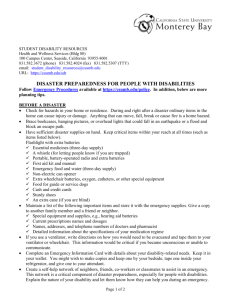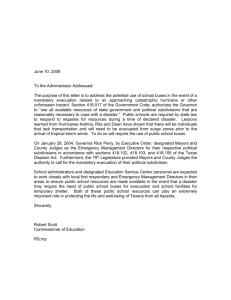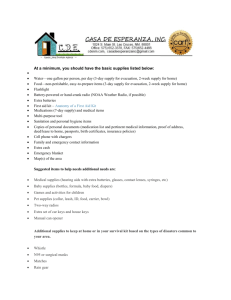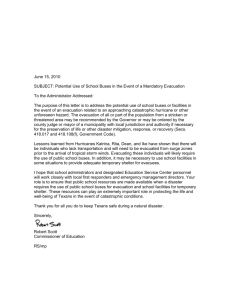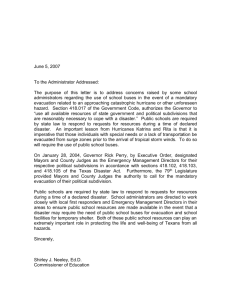ASEAN-ITU Seminar on ICT Accessibility and Assistive Technologies
advertisement
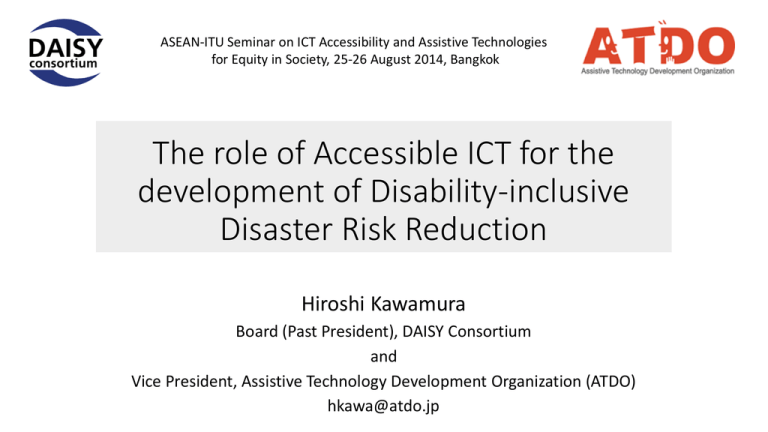
ASEAN-ITU Seminar on ICT Accessibility and Assistive Technologies for Equity in Society, 25-26 August 2014, Bangkok The role of Accessible ICT for the development of Disability-inclusive Disaster Risk Reduction Hiroshi Kawamura Board (Past President), DAISY Consortium and Vice President, Assistive Technology Development Organization (ATDO) hkawa@atdo.jp th January 17 1995, Kobe Source: http://ja.wikipedia.org/wiki/%E9%98%AA%E7%A5%9E%E3%83%BB%E6%B7%A1%E8%B7%AF%E5%A4%A7%E9%9C%87%E7%81%BD Hyogo Framework for Action (HFA) • Based on the lessons learned from 1995 Disaster in Japan, UNISDR set out the “Hyogo Framework for Action 2005-2015: Building the Resilience of Nations and Communities to Disasters” as United Nations International Strategy for Disaster Risk Reduction. ( http://www.unisdr.org/we/coordinate/hfa ) • The key message for Accessible ICT Development is “Rescue teams from outside of your own community may not reach in time to save lives of those who are buried under the wreckage. Only 1.7% of survivors were pulled out of the wreckage by the rescue team.” => Self-help and mutual help at community level was identified as a key survival factor. However, HFA was not sufficient to develop and share “how to”. On 11th March 2011, Tsunamis took 74 lives out of 108 students and 10 lives out of 13 teachers at Ookawa Elementary School in Ishinomaki City, Japan. However, students in Kamaishi City could evacuate successfully thanks to training and timely self-decision making. photo: http://photo.sankei.jp.msn.com/panorama/data/2011/0324ookawa01/ March 11th, 2011, Kamaishi, North East Japan Source http://www.youtube.com/watch?v=ARv_4a_8FBA March 11th, 2011, Kamaishi, North East Japan Source http://www.youtube.com/watch?v=ARv_4a_8FBA March 11th, 2011, Kamaishi, North East Japan Source http://www.youtube.com/watch?v=ARv_4a_8FBA Urakawa Bethel’s House • • • • • • Urakawa Bethel’s House is a self-advocacy group of persons with psycho-social disability and other disabilities consisting of 150 members. Most of the members are living in the community. 3000 visitors come and learn from them each year. Members go around the country to give 100 lectures annually. Annual Conference of Psycho-social Rehabilitation Professionals 2010 was hosted by the Bethel’s House. The main-event was designated to “Disaster Risk Reduction as an Opportunity to Link with the Community”. Further info is available at http://bethel-net.jp/bethel-e.html Members of the Bethel’s House are living in Urakawa Town, the most frequent earthquake zone in Japan Urakawa Town On-site international study on Disaster Preparedness in Urakawa, May 2005. Most of them including George Kerscher and Markus Gylling continue to work on development of accessible EPUB3 still now. WSIS November 2005 in Tunis A Screenshot of one of Evacuation Manuals Text, graphics and narrations are synchronized Samples in English, Thai and Japanese are available: A Screenshot of one of Evacuation Manuals Evacuation Drills of Urakawa Bethel’s House • Individuals with severe psycho-social disability and other disabilities has been training themselves since 2005 to prepare for Tsunami. •With 4 evacuation training sessions per year, they refresh scientific knowledge on Tsunami and develop skills to evacuate to higher than 10 m within 4 minutes. •They maintain evacuation manuals in DAISY multimedia format by themselves. Bethel’s House representatives presented their preparedness development project at the 2nd International Conference on Disaster Preparedness for Persons with Disabilities, 12-13 May 2009, Phuket. Bethel’s House members joined community disaster risk reduction workshop in Urakawa Town, September 2009, followed by one night stay simulation at a evacuation shelter. On March 11th 2011, 60 Bethels’ House members led the evacuation of total 500 people before the Tsunami came as they trained themselves to evacuate immediately after the quake. There was no human casualties in Urakawa in spite of a large property loss by 2.8m tsunami attack. 0.3 0.3 0.4 3.4=22/6.4 0.4 0.5 2.4=24/10 0.9 1.3=19/14 Fig.1 Proportion of death by age: Older than 60 years occupied 65% of the victims of the North East Japan Earthquake and Tsunami in 2011. Key lessons from the 3.11 2011 Disaster • Informed and Timely Decision Making based on appropriate DRR plan and evacuation drills at community level is the key to survival. • Well trained School kids and members of Urakawa Bethel’s House are good examples of timely decision making for evacuation. • Regardless of disabilities or other risk factors, appropriate and accessible scientific knowledge, training and accessible early warning save lives. • As hundreds of community based rescue operators were killed in operation, rescue teams are requested to secure their safety first. => Everybody in the community including persons with disabilities and old aged people in Japan are requested to prepare for survival. • Disability-inclusive Disaster Risk Reduction requires accessible ICT. Who were at risks? Those who are not able to: Understand the situation Communicate Locate the evacuation route Evacuate Participate in the community activities including evacuation drills [persons with disabilities, old aged people, small children, travelers, those who are pregnant, who require medical treatment, who are living with minority languages, etc.] What is the discrimination in Disaster Risk Reduction? Less survival chance caused by denial of reasonable accommodations where the basic design is not inclusive, such as lack of • access to knowledge on risks and risk reduction measures • access to preparedness development including evacuation drills • timely early warning in an accessible and easy to understand format • assistance for evacuation • accessible evacuation route • accessible shelters • participatory process for “build back better” • communications in accessible format Librarian’s Initiatives for Recovery from Yolanda Archiving Stories of Survivors All textbooks and libraries including Eastern Samar State University Guiuan Campus Library in the photo are completely lost by the typhoon Yolanda. Key Players for Survivor’s Story Archiving in DAISY Multimedia Format • • • • • • • Story tellers (Authors) Libraries (National, Regional and Local) Schools and Universities Local governments Researchers Disability Community International Cooperation Agencies Example of DAISY multimedia Downloading of The Story of the Three Little Pigs is kindly offered by the Information Center of the Japanese Society for Persons with Disabilities: ftp://ftp.jsrpd.jp/pub/daisy/download/pigsE.zip Near Future of DAISY Open Standards for “Accessible Multimedia” (CRPD Article 2) development best meet the diversity needs of persons with disabilities and the general public. Commitment of Libraries and librarians to support participation of persons with disabilities who address their own needs from grass roots level to policy decision making level through provision of accessible and easy to understand reading experiences will revitalize the library services in the near future. This HLMDD Outcome Document in accessible multimedia format is available at: http://www.un.org/disabilities/documents/hlmdd/daisy/Sign_Language/index.html Access to knowledge, information and communication on disaster risk reduction in accessible and understandable format saves lives of persons with disabilities and the rest of the community. References • United Nations CRPD Portal Web http://www.un.org/disabilities/ • Disability Information Resources (DINF) at Japanese Society for Persons with Disabilities http://www.dinf.ne.jp/doc/english/index_e.html • DAISY Consortium http://www.daisy.org/ • International Digital Publishing Forum http://idpf.org/ • World Wide Web Consortium http://www.w3.org/


